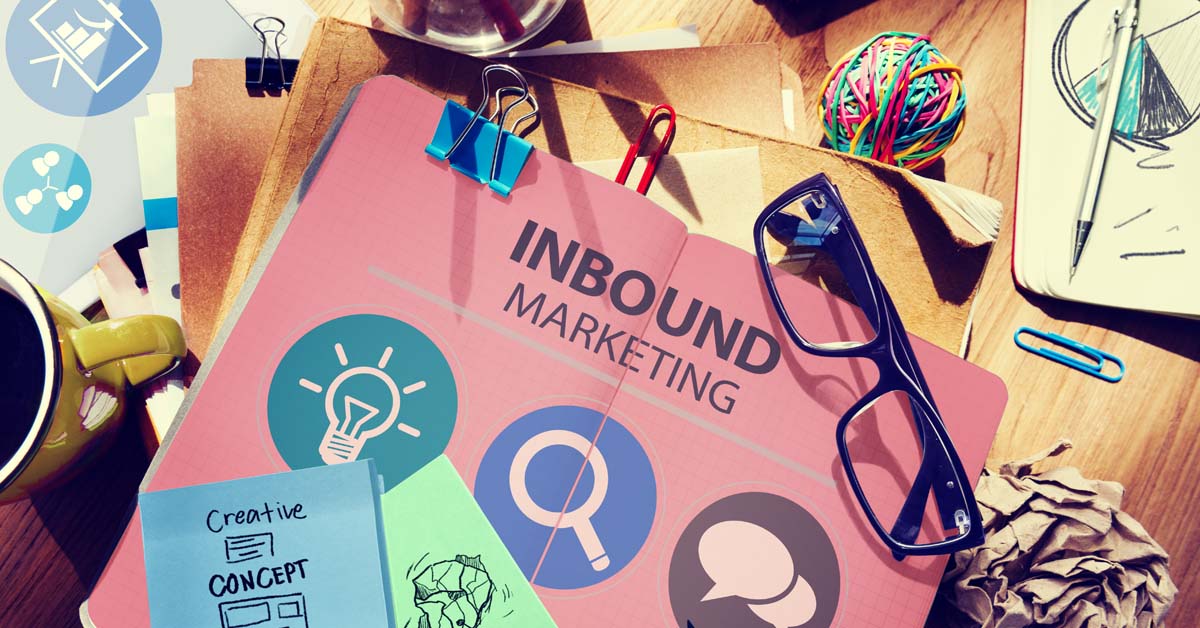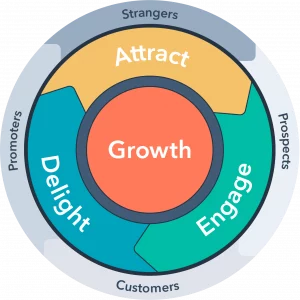If you’re in the realm of digital marketing, you’ve probably heard the phrase “inbound marketing” a couple of times. Plenty of marketers emphasize the importance of inbound marketing in their digital strategy. While it’s easy to grasp the basics, inbound marketing can be a tricky, but cost-effective process that lets you convert customers organically (and save your advertising budget).
 What is Inbound Marketing?
What is Inbound Marketing?
Inbound marketing is a marketing methodology that highlights the importance of content creation to attract customers and move them through your sales funnel. Essentially, it involves building customer relationships through relevant social media posts, email campaigns, or mobile-friendly ads.
Plenty of marketers have emphasized the importance of inbound marketing and for a good reason. Here’s why:
- 41% of marketers say inbound marketing leads to measurable ROI.
- 82% of marketers observe positive ROI for their inbound marketing efforts.
- If correctly done, inbound marketing can be 10x more effective in converting leads than outbound.
- Inbound marketing generates 3x more leads per dollar compared to traditional marketing.
- 91% of consumers prefer brands that are authentic in their social media posts, according to a study by Bonfire Marketing.
These numbers prove inbound marketing is a cost-effective tactic that can boost profits and simultaneously ensure your advertising budget is well-spent.
A good inbound marketing strategy will offer quality content like eBooks, case studies, webinars, or email campaigns aligned with consumers’ needs and interests. If you can position your business as a valuable resource, then expect more sign-ups and repeat purchases.
How Inbound Marketing Works
The inbound methodology depends on content creation to build meaningful relationships with leads and consumers. Every stage in the sales funnel is resource-heavy. The more high-quality content you have, the more likely you’ll attract visitors, nurture leads, and close deals.
Hubspot divides this process into four steps: attracting customers, engaging customers, and delighting customers. Each stage has various forms of content to plan for.
 Why use an inbound marketing strategy?
Why use an inbound marketing strategy?
There are three significant reasons why inbound marketing works better than other methods. Here’s a look at some of its distinct advantages, as well as strategies to help you get started.
1. Inbound marketing is a cost-effective strategy
You only need a website and content to get started with inbound marketing.
For small businesses, the start-up costs required to build a following for your blogs and social media accounts may seem intimidating. However, you can start small and scale as your business grows.
You can also modify your campaigns based on the previous campaigns’ results to get the most bang for your buck.
In contrast, traditional tactics like TV advertisements, print, billboards, and posters are a lot more expensive. While these can boost awareness, they’re just not as effective at engaging and retaining customers.
2. Tech-savvy customers prefer inbound marketing
In the age of social distancing, traditional marketing tactics are losing traction with customers.
In 2020, Search Engine Land reports that since the global pandemic, inbound marketing tactics like paid search and social media increased by up to 26%. In contrast, television, print, and direct mail have declined by up to 46%.
It’s evident that inbound marketing is the future.
As more people opt to stay indoors, they invest more time on digital platforms. As a result, they’re also more likely to use online information to discover brands and guide their purchasing decisions.
3. Inbound marketing has long-term value
Inbound marketing content such as instructional guides, infographics, case studies, or e-books has a longer lifespan than outbound content. You can increase its usability by updating and republishing your content to keep it relevant and timely.
In comparison, traditional marketing tactics are short and sweet. A salesperson can spend hours cold-emailing and -calling potential leads in exchange for a handful of sales, but there’s no guarantee that you can build trust and meaningful long-term relationships this way; rather, it’s more of a numbers game.
4. Inbound marketing is authentic
According to the Edelman Trust barometer, 81 per cent of respondents consider trust when evaluating their purchase decisions. Unfortunately, they’re also used to ads with big promises which never follow through. That’s why inbound marketing strategies that involve publishing actionable and interesting content seems more authentic in the long run.
Inbound marketing strategies
Now that you understand how inbound marketing works, it’s time to put these ideas into action. This marketing methodology requires several types of content to maximize effectiveness.
Let’s talk about the various inbound marketing strategies and some best practices for boosting engagement.
1. Research your buyer persona
The crucial first step to any successful inbound marketing strategy is to create a buyer persona.
For starters, a buyer persona identifies the behavior, needs, lifestyle, and demographics of customers. In the process, you’ll be able to create compelling content that resonates with your audience.
If you have relevant data on your existing customers (or leads), examine web metrics like mobile traffic, bounce rates, page traffic, and conversion rates. Then, go beyond the numbers by looking at individual user profiles, call outcomes, and overall revenue.
If you don’t have this data, that’s okay. Ask customers to fill out online surveys or answer a few questions by phone, so that you can gather information. Tools like Type Form and Google Form can help you build and launch surveys for customers.
2. Segment customers
Next, segment customers based on trends, patterns, or behavioral data.
Divide up customers based on their demographic information such as age, gender, and location.
Some eCommerce stores launch email marketing campaigns based on a customer’s stage in the sales funnel. For example, suppose you sell a CRM tool, and you’re selling to a group of three customers:
- Mandy (small business owner): Mandy is a twenty-something first-time entrepreneur. She wants to attract local customers to her brick and mortar store.
- Lucas (Marketing lead): Lucas is a 30-something marketing executive. He wants to automate marketing tasks, optimize conversion rates, and build custom reports for his team.
- Kieran (Enterprise CEO): Kieran is a CEO of an enterprise managing multiple teams and brands. He is looking for a CRM tool that can streamline team tasks and provide advanced reporting capabilities.
Each segment has different needs and characteristics. To get them through your sales funnel, create resources that frame your product as the solution to their problems.
3. Create helpful email campaigns
Growing your email list is crucial to a successful inbound marketing campaign.
Oberlo reports that for every $1 spent on email marketing, you can expect an average return worth $42. Also, 81% of small and medium businesses rely on email as their primary tool for customer acquisition, and 80% rely on it for retention.
Before these numbers compel you to bombard your contacts with emails, make sure they’re relevant to subscribers first. When it comes to emails, quality beats quantity every time.
A good tip is to segment customers based on their needs. New customers may need to go through an onboarding email campaign to learn the ins and outs of doing business with you. Meanwhile, existing customers may need re-engagement emails, newsletters, and updates to return to your online store to make a purchase regularly.
For example, The Muse, a job search and career advice website, sends newsletters with top companies currently hiring and links to open positions. This is valuable information for their subscribers who are looking for their next job.
4. Create social media campaigns to attract your audience
There are 3.5 billion social media users worldwide.
More people will be using social media to discover brands and follow businesses that align with their values and interests in the foreseeable future. These circumstances make it an ideal channel to attract new customers and maintain relevance among current customers.
The jury is out on the style of social media content customers prefer, too: 91% of customers prefer brands that remain authentic in social media. Besides stunning product photos, customers want videos and behind-the-scenes looks to highlight the brand’s values and purpose.
5. Launch MOFU / BOFU content
Besides attracting new customers, social media marketing is ideal for customers in the MOFU (Middle-of-the-Funnel) and BOFU (Bottom-of-the-Funnel).
Having said that, you’ll want to create posts with links to case studies, landing pages, whitepapers, and blog posts. While a gorgeous photo can attract new customers, buyers are more interested in learning the specs and features to make an informed purchasing decision.
For example, PlayStation posted high-quality pictures of their upcoming PS5 on their Facebook page, but there’s also a link to a landing page with technical information for gamers who want to upgrade their console.
6. Optimize for mobile
There are 5.22 billion mobile users worldwide.
According to Broadband Search, 55.9% of traffic is from desktop users, while 40.1% is from mobile users. Google is also eliminating sites from mobile search SERPs if they’re not mobile-friendly.
This means it’s crucial to optimize your website and mobile content (or risk losing business online).
A mobile-friendly site entails finding a responsive template, embedding bigger, clickable CTAs, using large fonts, and optimizing images.
We highly recommend using Google Pagespeed Insights to identify page loading times. Even if your site is optimized for mobile, customers expect pages to load in 2 seconds or less, or they’ll jump back into their Facebook feed and forget about your brand.
7. Create “Power Posts”
Buzzsumo analyzed 1 billion articles and found that the top 1.3% of articles drove 50% of social shares.
Backlinko founder Brian Dean called these top articles “Power Posts.”
These refer to high-quality or in-depth guides that end up on the top of Google’s search results.
For example, Brian Dean’s power post titled, “How to Write a Blog Post: The Definitive Guide”—earned 10,555 visitors in one week and 5369 total social shares!
Rather than quantity, Brian Dean’s strategy revolves around taking time to create one post. He invested 50 hours of work in writing, designing, editing screenshots, and coding the page for a single post.
By creating the best possible blog, Brian Dean can gain tons of engagement for every post he makes. While he doesn’t publish new content often, he proves that slow and steady can win the race in inbound marketing.
8. Host a webinar or online courses
Many in-person events and conferences have been cancelled due to the pandemic, but all hope is not lost.
In recent months, businesses have opted for free webinars that provide invaluable guidance to viewers. The advantage is that viewers can download the content, replay parts, and ask questions in real-time.
The best part? It’s cheaper to host an online webinar than creating an in-person event. All you need is a microphone and a camera—then you’re good to go. If you’re not quite ready to go live, opt for a pre-recorded webinar to avoid mistakes and edit the video.
For example, Hubspot frequently hosts free webinars for advertising, analytics, and marketing. Each course is taught by online experts, which ensure their subscribers learn valuable information. At the same time, these online sessions help propel them as an authority in the industry.
Conclusion
Inbound marketing is the future in a tech-savvy world. Launching an inbound marketing strategy is a worthwhile investment that can help your business attract customers, build trust, and foster loyalty in the long term. As you plan your promotions, focusing on an inbound methodology is a wise choice that will positively impact your customers and your business.
Learn more about Inbound Marketing and how it relates to your business today.

Stay Connected